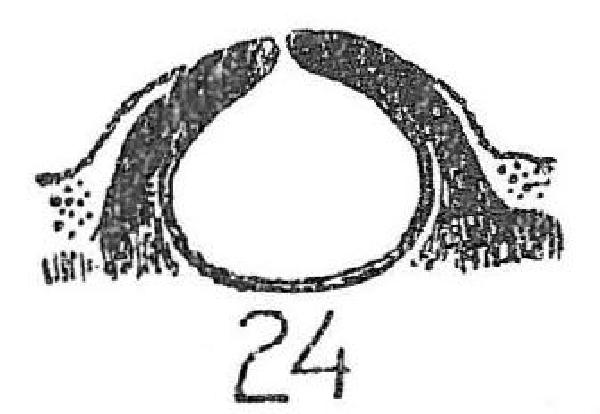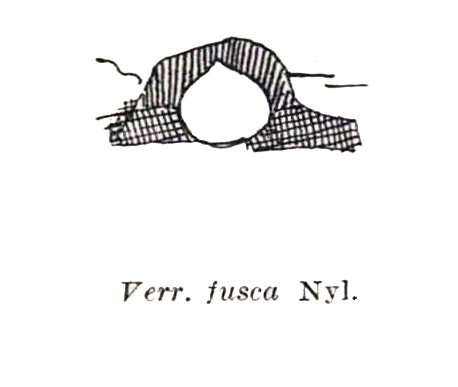Verrucaria fusca Pers.
in Ach., Lich. Univ.: 291, 1810
Synonyms: Verrucaria triglavensis Servít ?
Distribution: N - TAA (Nascimbene & al. 2022).
Description: Thallus crustose, thinly episubstratic, dark olive to brown-black, consisting of 0.1-0.25 mm wide flecks which are not subgelatinous when wet, often developed only around the perithecia, sometimes with a brown to black, fimbriate prothallus. Cortex consisting of a single layer of brown cells, most of the thallus thickness being occupied by the algal layer; medulla poorly developed. Perithecia black, hemispherically projecting, 0.25-0.3 mm wide, covered by a thin thalline layer at base. Involucrellum 30-50 μm thick laterally, becoming thicker downwards (up to 70 μm), reaching down to at least 2/3 of the perithecium, usually up to base-level, almost totally adpressed to exciple except at the very base, where the space between exciple and involucrellum is separated by a thin area of brown-walled cells; exciple subglobose to subpyriform, 0.2-0.3 mm across, the wall brown throughout; hamathecium of 15-25 μm long periphyses and periphysoids, interascal filaments absent; hymenial gel hemiamyloid, I+ red (I+ blue at very low concentrations of I), K/I+ blue. Asci 8-spored, clavate, I-, fissitunicate, the wall thickened above, with an ocular chamber, dehiscent by extrusion of an endotunica to form a delicate rostrum, Verrucaria-type. Ascospores 1-celled, hyaline, elongate-ellipsoid, 18-23(-27) x (6-)7-10(-13) μm. Photobiont chlorococcoid. Spot tests: K-, C-, KC-, P-, UV-. Chemistry: without lichen substances.Note: an often misunderstood taxon, found both on calciferous and siliceous rocks, usually growing as a pioneer in rather sheltered situations, reported from several localities in Central Europe, incl. the Alps. Muchnik & Breuss (2015) attributed to this species a subgelatinous thallus, but according to Pykälä (in Oïhénart & al. 2018) the type of V. fusca has a non-subgelatinous thallus.
Growth form: Crustose
Substrata: rocks
Photobiont: green algae other than Trentepohlia
Reproductive strategy: mainly sexual
Commonnes-rarity: (info)
Alpine belt: absent
Subalpine belt: very rare
Oromediterranean belt: absent
Montane belt: very rare
Submediterranean belt: absent
Padanian area: absent
Humid submediterranean belt: absent
Humid mediterranean belt: absent
Dry mediterranean belt: absent

Predictive model
Growth form: Crustose
Substrata: rocks
Photobiont: green algae other than Trentepohlia
Reproductive strategy: mainly sexual
Commonnes-rarity: (info)
Alpine belt: absent
Subalpine belt: very rare
Oromediterranean belt: absent
Montane belt: very rare
Submediterranean belt: absent
Padanian area: absent
Humid submediterranean belt: absent
Humid mediterranean belt: absent
Dry mediterranean belt: absent

Predictive model
 DOLICHENS
DOLICHENS



